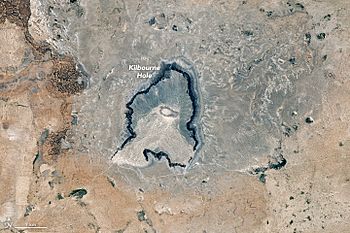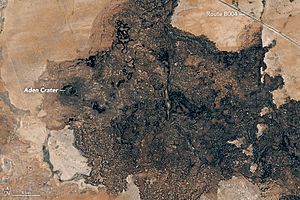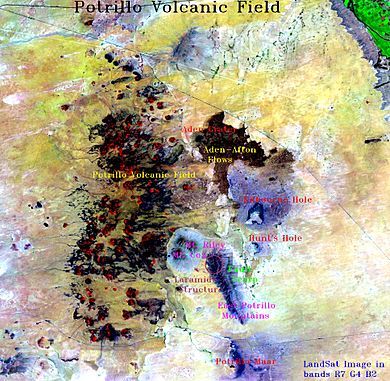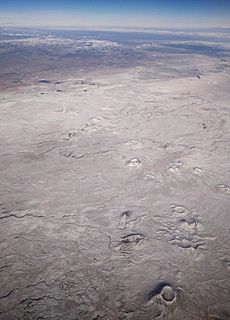Potrillo volcanic field facts for kids
Quick facts for kids Potrillo volcanic field |
|
|---|---|

Potrillo volcanic field viewed from space, 2017. Outlined areas have blowups in text below. Interstate 10 is at the top of this image, and NM-9 and the US-Mexican border are at the bottom (south). The prominent white line diagonally across the top appears to be a major electrical transmission line.
|
|
| Highest point | |
| Elevation | 5,561 ft (1,695 m) |
| Prominence | 657 ft (200 m) |
| Geography | |
| Location | New Mexico, United States / Chihuahua, Mexico |
| Geology | |
| Age of rock | < 2.65 million year |
| Mountain type | Volcanic field |
| Volcanic arc/belt | Rio Grande rift |
| Last eruption | > 150,000 years ago |
The Potrillo volcanic field is a special area in southern New Mexico, United States, and northern Chihuahua, Mexico. It's called a monogenetic volcanic field because it has many volcanoes that usually erupt only once. This field is part of the Rio Grande Rift, which is a huge crack in the Earth's crust.
The Potrillo volcanic field is about 22 miles (35 km) southwest of Las Cruces. It covers a large area of about 4,600 square kilometers (1,776 sq mi) near the border between the U.S. and Mexico.

Contents
Volcanoes and Lava
The Potrillo volcanic field is huge, covering much of Doña Ana County. It's made up of three main volcanic areas:
- West Potrillo Field: This western part has over 100 cinder cones. These are cone-shaped hills made from volcanic ash and rock. It also has two maar volcanoes, which are wide, flat craters formed by explosive eruptions. This area covers about 1,250 square kilometers (483 sq mi).
- Aden–Afton Field: In the center, this area has newer lava flows, three cinder cones, and three maar volcanoes. One famous maar here is Kilbourne Hole. This field is about 230 square kilometers (89 sq mi) big.
- Black Mountain-Sao Thomas alignment: This eastern area is a line of volcanoes near the Rio Grande. It includes places like Santo Tomas and Black Mountain.
Most of the volcanoes in this field are made of a type of rock called olivine basalt.
How Old Are the Lava Flows?
Scientists can figure out the age of the lava flows. For example, lavas from Black Mountain are about 69,000 to 85,000 years old. To do this, they collect small samples from the top few centimeters of the lava. These samples show features like cooling patterns, which help scientists understand how the lava flowed.
The central Aden-Afton field includes the Aden and Afton areas. Aden is a well-preserved shield volcano. It once had a lake of lava inside, which later hardened. The lavas from Aden are about 15,000 to 19,000 years old.
The western West Potrillo field is the oldest part of the Potrillo volcanic field. Its lavas range from 262,000 to 916,000 years old. This area has hundreds of cinder cones and lava flows stacked on top of each other.

Ancient Discoveries
One amazing discovery was made in a lava tube at Aden Crater. Scientists found the skeleton of a ground sloth, which is an extinct animal similar to a modern sloth. This skeleton is about 11,000 years old. What's really cool is that parts of its skin and hair were still preserved! This rare find is now at Yale's Peabody Museum of Natural History.
Rocks from Deep Inside Earth
The Potrillo volcanic field is special because it has many xenoliths. These are pieces of rock that were carried up from deep inside the Earth during a volcanic eruption. They are like clues that tell us what the Earth's mantle (the layer below the crust) and lower crust are made of.
Kilbourne Hole and Potrillo maar are famous for these xenoliths. Most of the mantle xenoliths here are made of a rock called lherzolite. This rock is mostly green olivine with black specks of pyroxene. Sometimes, another rock called peridotite is also found.
These xenoliths are very important to scientists. They are the only way to study rocks from parts of the Earth that we can't reach by digging or drilling.
How Scientists Date Rocks
Scientists use a method called cosmogenic 3He surface dating to find out how old lava flows are. This method measures tiny amounts of a special type of helium (called 3He) that builds up in rocks when they are exposed to cosmic rays from space. The more 3He they find, the longer the rock has been on the surface, and the older it is. This method works best for lava flows that are less than 700,000 years old.
| Surface-exposure ages of samples from Potrillo volcanic field | ||
|---|---|---|
| Description | 3He/21Ne (melt) | Age "Ka" (melt) |
| Black Mountain | ||
| Upper flow associated | 2.6 ± 0.6 | 77 ± 4 |
| Cinder cone | 3.0 ± 0.5 | 85 ± 7 |
| Lower flow | 2.6 ± 0.5 | 69 ± 5 |
| Afton volcanic center | ||
| Flow resting on La Mesa | 2.4 ± 0.3 | 72 ± 4 |
| surface | 2.3 ± 0.3 | 81 ± 4 |
| Aden volcanic center | ||
| Flow collected 5 km | 2.5 ± 1.2 | 16.9 ± 3 |
| From Aden crater | N/A | 15.9 ± 2 |
| Spatter cone in Aden | N/A | 15.7 ± 2 |
| Crater | 1.5 ± 0.5 | 17.9 ± 2 |
| Lava lake within crater | N/A | 18.2± 3 |
Cinder Cone Shapes and Ages
The Potrillo volcanic field has over 100 cinder cones. These cones range in age from 1 million to 20,000 years old. Scientists have noticed that the shape and steepness of these cones change over time due to weather.
By comparing the age of the cones (found using methods like the helium dating mentioned above) with how steep their slopes are, scientists can learn about their age. They have found three main groups of cinder cones based on their age and slope:
- Group 1: About 250,000 years old.
- Group 2: About 125,000 years old.
- Group 3: About 60,000 years old.
This suggests that new cinder cones might still be forming in the Potrillo volcanic field today!
Notable Volcanoes

| Name | Elevation | Coordinates | Last eruption |
| Aden Crater | - | - | 16,000 years ago |
| Hunt's Hole | - | - | - |
| Kilbourne Hole | 1,292 m (4,239 ft) | 31°58′N 106°58′W / 31.97°N 106.97°W | 80,000 years ago |
| Malpais tuff ring | - | - | - |
| Potrillo Maar | - | - | - |
| Mount Riley | - | - | - |



